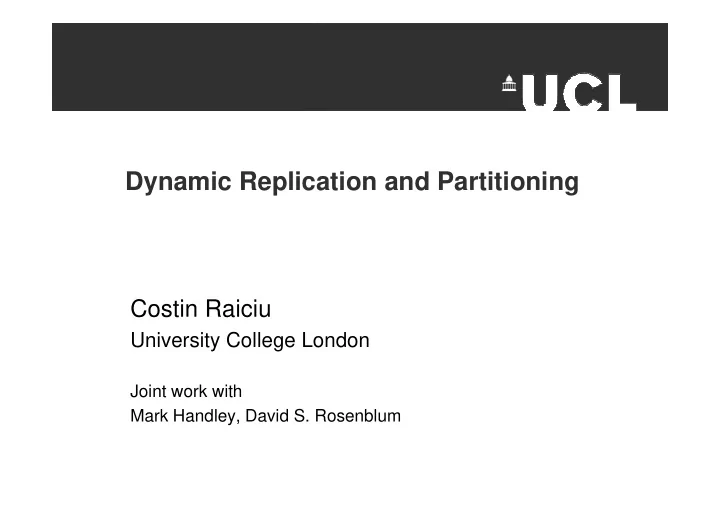

Dynamic Replication and Partitioning Costin Raiciu University College London Joint work with Mark Handley, David S. Rosenblum
Motivation: Web Search • Search engines – Create an index of the web – Queries consult the index to find relevant documents – The documents are then ordered (e.g. Page Rank) • The index is huge: a few TB – Must be partitioned to fit into memory – Must be replicated to increase query throughput and system availability 2
Google Web Search (Barroso et. al) Index split in Shards Query Cluster 1 Cluster 2 Cluster 3 Merge and order results 3
Big Picture: Distributed Rendez-Vous Query Load Balancer Index Overlay Node Shard Average Replication Level R=5 Hop Count H=3 4
Distributed Rendez Vous is important • Many other applications use it – Online Filtering – Distributed databases • Combines replication and partitioning – Increasing replication (R) increases availability, but has high cost for storing the index – Increasing the forwarding hops (H) creates high bandwidth cost for transient objects – Tradeoff: R·H ≥ #nodes 5
The Problem • Who chooses the number of clusters? Depends on: – Frequencies and sizes of index and queries – Bandwidth constraints – Memory constraints – Number of nodes • R varies with time! How can we adjust the Replication Rate in distributed rendez-vous? 6
Obvious approach • Google architecture – Replication tied to network structure – Increase replication level • Destroy cluster, add the nodes to the other clusters – Issues • Temporarily reduces the capacity of the network • Not simple to implement X • Google solution: buy more hardware Cluster 1 Cluster 2 Cluster 3 7
A randomized implementation Query N=15 R=5 H=3 Index Shard To increase the replication level, each node On average, each query meets each index shard creates 1 new replica for active queries once 8
Our solution: ROAR • R endez-Vous O n A R ing – Similar in spirit to Random – But with deterministic properties – Does not tie network structure to replication level 9
ROAR Overview • Nodes on a Chord ring • ID space virtually split in R intervals • Replicate – Hash and store Query Index – Forward to equivalent Shard node in next interval • Route – Uniformly choose interval and direction – Route to all nodes in that 0 max interval Replication Level: 5 10
ROAR Analysis • Equal spacing is important – When R increases, it ensures that no 2 replicas are in the same interval – Stable state: if R is constant enough time, equivalent nodes have equivalent content • Useful for fault tolerance – When R changes: • Stability is maintained if R is doubled of halved • Otherwise, not stable: wait for objects to expire 11
Increasing Replication 0 max Replication Level: 5 -> 6 12
Increasing Replication (2) • Observation . When replication level is R, we can route at any level R’ ≤ R. • ROAR can route while changing replication levels – Wait until all nodes in interval reach new replication – Begin routing at new replication level • When is the new replication level reached? – Compute persistent object count at replication level R and R+1 • When approximately equal, safe to switch to new routing. – Count is piggybacked on queries - very small cost 13
Fault Tolerance Stable state Query X 14
Fault Tolerance Not in stable state Query X 15
Comparison • Bandwidth scarce system – R = O( √ N) – I = # total size of index Google Random ROAR 35% RV Guaranteed? Yes Yes miss probability 25% RV Redundant? No No redundant RV probability Bw for R = R+1 ~2·I I I Bw Cost on Node O(I·R/N) 1 O(I·R/N) Failure or 1 16
Comparison (2) • 1% permanent failures per year – Commercial data: 5% failures in 1st year – Transient failures tolerated with stable state �������������������� � ��� ROAR better � ��� � ��� Google better � ��� � � ����� ����� ����� ����� ������ ������ ��������������� 17
Summary • Distributed rendez-vous is an important problem in distributed computing – Changing R is a requirement for optimal solutions • ROAR - simple algorithm – Distributed in spirit • No need for external load balancing • Can run on deployed structured overlays – Achieves reconfiguration without changing network structure – In stable state as good as Google – When reconfigurations are often, does better 18
References • Web Search for a Planet: the Google Cluster Architecture - Barroso et. al 19
Recommend
More recommend